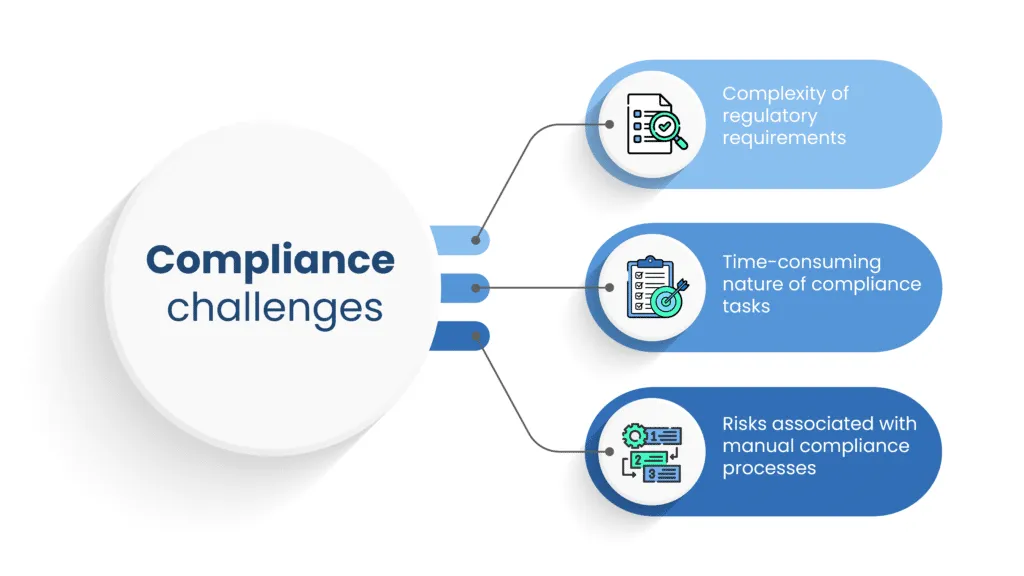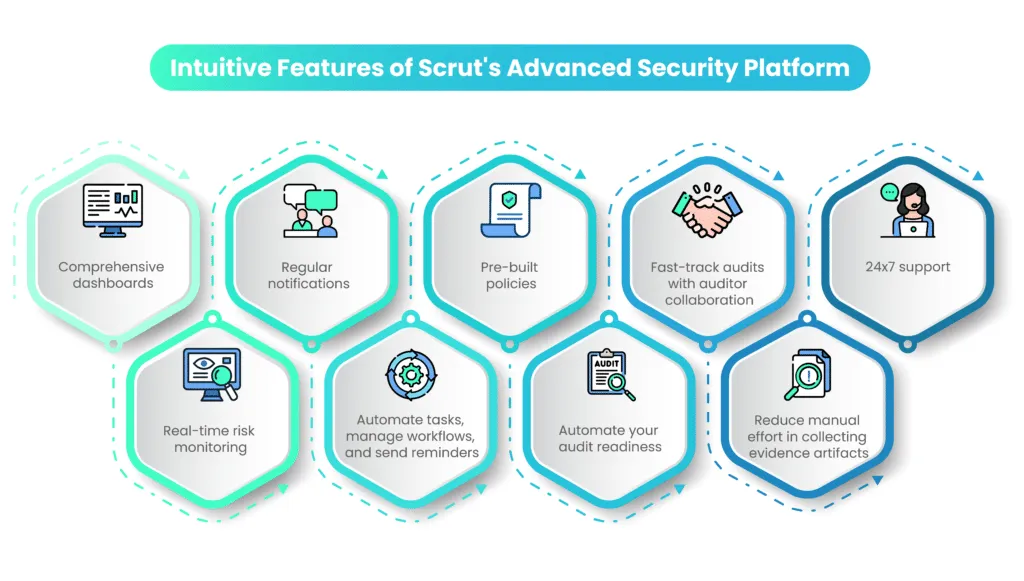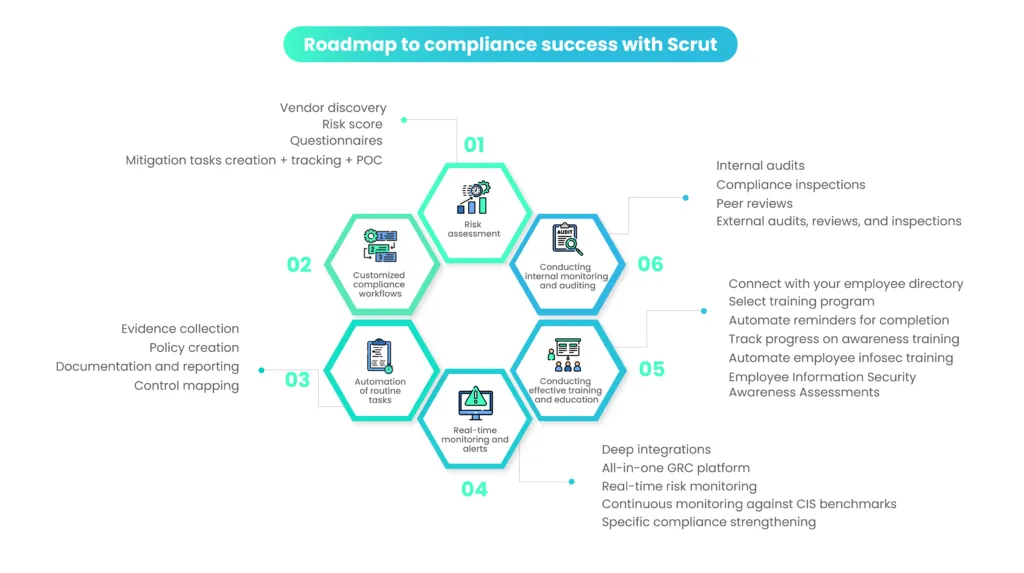Streamlining compliance with Scrut Automation
.webp)
Compliance is a critical facet of contemporary business operations, impacting everything from legal obligations to reputation management. With an intricate web of laws and standards, maintaining compliance has become a strategic imperative for businesses aiming for sustainable growth and ethical operations.
However, in the rapidly evolving landscape of today’s business world, organizations face an increasing number of compliance challenges. Regulatory requirements are becoming more intricate, necessitating a sophisticated approach to ensure adherence.
Failure to comply with regulations can result in severe consequences, such as financial penalties, legal action, and damage to a company’s brand image.
In response to the growing complexity of compliance challenges, innovative solutions like Scrut Automation have emerged to streamline processes and enhance risk observability. But before we dwell on the possibilities of streamlining compliance, let’s take a look at the challenges organizations face adhering to compliance requirements.
Understanding compliance challenges

1. Complexity of regulatory requirements
Navigating the intricate web of regulatory requirements has become a formidable task for organizations of all sizes. Regulations can vary across industries and regions and even change rapidly, making it challenging to stay abreast of all relevant mandates.
2. Time-consuming nature of compliance tasks
Manual compliance processes are often time-consuming, requiring significant human resources and attention to detail. The sheer volume of data and documentation needed for compliance can overwhelm traditional methods, leading to delays and increased operational costs.
3. Risks associated with manual compliance processes
Relying on manual processes exposes organizations to a myriad of risks, including errors, inconsistencies, and oversight. Human factors such as fatigue or oversight can contribute to compliance lapses, potentially resulting in legal consequences or reputational damage.
The complexity of these requirements demands a sophisticated approach to compliance management, prompting organizations to seek automated solutions that can adapt to the dynamic regulatory landscape. This is where Scrut comes into play!
Scrut Automation: Transforming compliance
Scrut Automation is a comprehensive compliance automation platform designed to alleviate the burden of manual compliance tasks. By leveraging advanced technologies, Scrut empowers organizations to automate compliance processes, mitigate risks, and ensure a proactive approach to regulatory adherence.
Intuitive features of Scrut’s advanced security platform.

Scrut Automation stands as a comprehensive solution, offering a suite of features designed to enhance organizational security and streamline risk management processes.
- Comprehensive dashboards: Get real-time insights into your organization’s cybersecurity metrics, compliance status, and vulnerabilities with Scrut’s dashboards. With Scrut’s intuitive visuals, users can quickly assess their security posture, track compliance, and identify areas needing attention. You will receive actionable information for informed decision-making, through a centralized hub for efficient cybersecurity management.
- Regular notifications: Integrate your preferred messaging services and/or email providers with Scrut to receive alerts and notifications, allowing you to stay informed about compliance issues that require attention.
- Pre-built policies: The platform’s features include pre-built policies vetted by industry experts and aligned with popular industry frameworks. Customize these policies using the built-in inline editor to tailor them to your unique business needs.
- Fast-track audits with auditor collaboration: Simplify the audit process by inviting auditors to the platform. Manage the entire audit lifecycle in real time, eliminating the need for cumbersome email exchanges and file sharing. Scrut streamlines collaboration, ensuring a seamless and efficient audit experience.
- 24×7 support: Scrut stands out with its 24/7 support, ensuring continuous assistance for organizations navigating the complexities of cybersecurity. Whether it’s troubleshooting technical issues, seeking advice on compliance challenges, or simply gaining insights into the platform’s functionalities, Scrut’s 24/7 support ensures that users have prompt access to knowledgeable professionals, contributing to a seamless and secure cybersecurity management experience.
- Real-time risk monitoring: Scrut facilitates real-time monitoring of risks across your infrastructure and application landscape. Continuously stay compliant with 20+ compliance frameworks by creating controls aligned with your specific risks. Define custom controls to reflect your company’s unique needs and utilize pre-built control mapping to align them with necessary compliance frameworks.
- Automate tasks, manage workflows, and send reminders: Scrut facilitates task automation, workflow management, and reminder notifications. Assign tasks to team members, track their progress, and collaborate seamlessly within Scrut. The platform ensures efficient internal team communication and task management.
- Automate your audit readiness: SmartGRC™ streamlines and automates audit-related tasks, reducing manual effort by up to 75%. Increase accountability, accelerate infosec task completion, and enhance collaboration with auditors—all within a single window.
- Reduce manual effort in collecting evidence artifacts: Scrut Automation minimizes manual effort in collecting evidence artifacts by automating the process across 70+ integrations and mapped controls. This significantly streamlines compliance efforts, ensuring efficiency and accuracy in evidence collection.
Now that we’ve taken a brief look at the platform’s features, let’s map these to the steps required to achieve compliance with security standards.
Roadmap to compliance success with Scrut
Scrut has curated a suite of products applicable across various industries, bolstering security postures and elevating risk management practices. The platform’s automated procedures, including risk identification through the risk management module, policy implementation with smartGRC™, and continuous monitoring via the cloud diagnostics tool, enable organizations to maintain robust information security without impeding growth.

Step 1: Risk assessment
- Vendor discovery: Effectively managing vendor risks begins with a comprehensive analysis of the vendor landscape. Scrut Automation’s Vendor Management (VM) module introduces the “Vendor Discovery” feature. This functionality automatically scans your multi-cloud infrastructure for third-party applications that may function as vendors. The platform then presents a detailed register of these applications, allowing users to identify and categorize vendors efficiently.
- Risk score: Understanding the impact of each vendor during onboarding is crucial, but continuous monitoring is equally vital for proactive risk management. Scrut Automation calculates ongoing risk scores based on responses from questionnaires. These scores, both by domain and overall, are displayed in a clear overview, providing a real-time snapshot of each vendor’s compliance status.
- Questionnaires: Creating, distributing, and managing questionnaires is streamlined through Scrut Automation. Users can choose from pre-built templates or create custom questionnaires, set submission and review dates, and send them to relevant Points of Contact (POC). The platform offers a unique portal for recipients to respond to objective questionnaires, and the results impact the overall risk score.
- Mitigation tasks creation + tracking + POC: Identifying risks is just the beginning; effective collaboration is essential for remediation. Scrut Automation facilitates the creation and tracking of mitigation tasks directly from the platform. Stakeholders can communicate, add attachments, and monitor progress within each task. Audit logs and documentation ensure a comprehensive overview of mitigation efforts.
Step 2: Customized compliance workflows
One of Scrut Automation’s key strengths lies in its flexibility regarding compliance workflows. The platform acknowledges that each organization operates under its own set of circumstances, necessitating adaptable solutions.
It provides a tailored approach to compliance workflows, allowing organizations to align seamlessly with specific industry regulations. Whether it’s healthcare, finance, or any other sector, Scrut understands the nuances of diverse compliance requirements.
Scrut’s compliance workflows are designed to accommodate the dynamic nature of regulatory landscapes. Users can easily modify, expand, or streamline workflows based on evolving compliance needs, ensuring that the platform grows with the organization and remains a versatile tool for meeting regulatory challenges.
This flexibility empowers organizations to stay agile, responsive, and continuously aligned with the ever-changing demands of compliance standards.
Step 3: Automation of routine tasks
- Evidence collection: Scrut offers a seamless solution with over 70 pre-built integrations to collect evidence effortlessly. Leveraging these integrations, Scrut automates the evidence-gathering process, effectively addressing critical vulnerabilities. Simplify your compliance audits by consolidating rules, processes, controls, evidence, and documentation onto a unified platform with Scrut.
- Policy creation: Scrut goes beyond automation by offering infosec expert assistance in policy creation. This ensures organizations not only manage policies efficiently but also receive guidance from cybersecurity experts, creating comprehensive, tailored policies aligned with industry best practices. SmartGRC™ offers pre-validated policies curated by industry experts and crafted to adhere to widely recognized industry frameworks. Utilize the integrated inline editor to customize these policies to meet your unique business needs.
- Documentation and reporting: Scrut offers robust document management features to streamline your compliance documentation processes. From version control and access tracking to automated reminders for document updates, Scrut ensures that your documentation is always up-to-date and easily accessible.
- Control mapping: Scrut provides seamless control mapping, enabling organizations to align security controls with industry standards and regulatory frameworks effortlessly. This feature streamlines compliance processes identifies and bridges security gaps, and enhances overall cybersecurity resilience. With Scrut, businesses confidently navigate regulatory adherence with precision.
Step 4: Real-time monitoring and alerts
Continuous monitoring is paramount in maintaining a robust cybersecurity posture, especially in dynamic industries like SaaS, Fintech, and health tech, where cyber asset footprints are intricate, and adherence to multiple standards such as ISO 27001, SOC 2, GDPR, and NIST is essential.
Scrut Automation recognizes the significance of continuous monitoring as a proactive measure to identify and address emerging risks promptly.
Here’s how Scrut provides real-time alerts for potential issues
- Deep integrations: Scrut simplifies continuous security compliance through 70+ integrations with commonly used applications. This allows for effortless monitoring and seamless integration with various tools, creating a comprehensive solution for real-time risk monitoring.
- All-in-one GRC platform: Scrut serves as an all-in-one Governance, Risk, and Compliance (GRC) platform. The platform enables 24/7 compliance monitoring, allowing organizations to manage multiple compliance audits simultaneously through a unified interface.
- Real-time risk monitoring: Scrut enables real-time risk monitoring across infrastructure and application landscapes, ensuring continuous compliance with 20+ frameworks.
- Continuous monitoring against CIS benchmarks: Scrut offers continuous monitoring against Center for Internet Security (CIS) benchmarks, ensuring adherence to industry best practices.
- Specific compliance strengthening: Scrut aids in strengthening specific compliance areas such as SOC 2, GDPR, and PCI DSS through pre-built controls and continuous compliance monitoring.
Step 5: Conducting effective training and education
Effectively training and educating employees on compliance and information security is pivotal in building a resilient and secure organizational environment. Scrut Automation offers a comprehensive solution to streamline this process and enhance employee awareness.
Here’s how Scrut facilitates compliance training:
- Connect with your employee directory: Initiate your awareness training program seamlessly by connecting directly with your employee directory through the Scrut Automation dashboard. This integration ensures that all employees are included in the training initiative, promoting a comprehensive and inclusive approach.
- Select training program: Tailor your compliance training program according to the specific needs of your organization. Scrut Automation provides the flexibility to use pre-built training programs or customize them directly from the dashboard, ensuring that the content aligns with your company’s unique compliance requirements.
- Automate reminders for completion: Eliminate the manual effort involved in tracking and reminding employees to complete their training modules. Scrut Automation enables you to automate reminders, set alerts, and send personalized notifications to employees, ensuring timely and consistent participation in the training programs.
- Track progress on awareness training: Ditch the traditional manual tracking methods. Scrut Automation offers an automated dashboard that allows you to monitor the progress of your employees in real-time. This feature provides insights into who has completed the training, making it easy to identify and address any gaps in participation.
- Automate employee infosec training: Simplify the process of educating your employees on information security with Scrut Automation. The platform includes a prebuilt 30-minute course on information security, curated by industry experts. This comprehensive course equips employees with the knowledge to understand potential risks, avoid security lapses, and contribute to building a secure posture.
- Employee Information Security Awareness Assessments: Remove guesswork from monitoring employee awareness. Scrut Automation enables routine evaluations through quizzes and tests to measure your company’s information security culture. Configurable minimum score thresholds ensure that employees are well-informed and prepared to handle potential threats, contributing to a proactive security posture.
Step 6: Conducting internal monitoring and auditing
Scrut Automation provides a comprehensive suite of features to facilitate internal monitoring and auditing processes, ensuring organizations maintain a proactive stance in compliance and risk management.
- Internal audits: The system streamlines the audit process, allowing organizations to seamlessly define audit scopes, assign responsibilities, and generate reports. Automate the tracking of audit findings, corrective actions, and resolutions, ensuring a systematic approach to improving internal controls.
- Compliance inspections: Easily design inspection checklists, assign inspection tasks to relevant stakeholders, and track compliance with defined standards. Real-time monitoring and reporting capabilities enhance visibility, enabling organizations to address compliance gaps promptly.
- Peer reviews: Enhance collaboration and knowledge sharing within your organization through Scrut’s peer review functionality. Peer reviews can be conducted on policies, procedures, and other compliance-related documentation, fostering a collaborative and informed environment.
- External audits, reviews, and inspections: The platform serves as a centralized repository for all compliance-related documentation, streamlining the retrieval of necessary information during external assessments. Scrut’s robust audit trail ensures transparency and traceability, aiding in a smooth and successful external evaluation process.
Wrapping up
Scrut Automation emerges as a pivotal solution for organizations seeking an efficient and streamlined approach to compliance management. The platform offers a range of benefits, including automated policy enforcement, real-time monitoring, and evidence capture, ensuring a proactive and resilient compliance posture.
Whether you’re aiming to automate policy reviews, enhance employee training, or streamline internal audits, Scrut is the catalyst for a more efficient and effective compliance program.
Ready to experience the transformative power of Scrut Automation? Take the first step by booking a demo with our experts here.
Frequently Asked Questions
1. How does Scrut Automation support risk management and security across industries?
Scrut offers a suite of products designed for various industries, enhancing security postures and elevating risk management practices. Through automated procedures like risk identification, policy implementation with smartGRC™, and continuous monitoring via the cloud diagnostics tool, organizations can maintain robust information security without hindering growth.
2. How does Scrut Automation simplify vendor risk management with its Vendor Discovery feature?
Scrut Automation’s Vendor Management (VM) module includes the “Vendor Discovery” feature, automatically scanning multi-cloud infrastructures for third-party applications acting as vendors. This streamlines the vendor analysis process, presenting a detailed register for efficient vendor identification and categorization.
3. How does Scrut Automation calculate ongoing risk scores for vendors?
Scrut Automation calculates ongoing risk scores based on responses from questionnaires, providing real-time snapshots of each vendor’s compliance status. These scores, both by domain and overall, offer a clear overview, ensuring proactive risk management during onboarding and continuous monitoring.
4. How flexible are Scrut Automation’s compliance workflows to meet industry-specific regulations?
Scrut Automation’s key strength lies in its flexible compliance workflows, allowing organizations to tailor solutions to specific industry regulations. This adaptability ensures seamless alignment with diverse compliance requirements, accommodating the dynamic nature of regulatory landscapes.
5. How does Scrut Automation simplify evidence collection for compliance audits?
Scrut simplifies evidence collection with over 70 pre-built integrations, automating the gathering process and addressing critical vulnerabilities. By consolidating rules, processes, controls, evidence, and documentation onto a unified platform, Scrut streamlines compliance audits for a more efficient and consolidated approach.


















